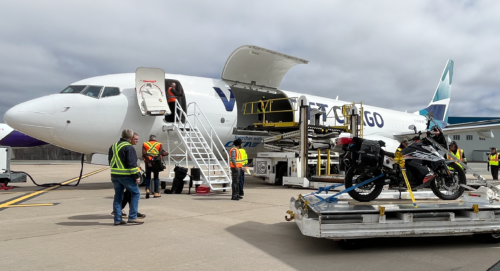Project Logistics: Achieving the Impossible
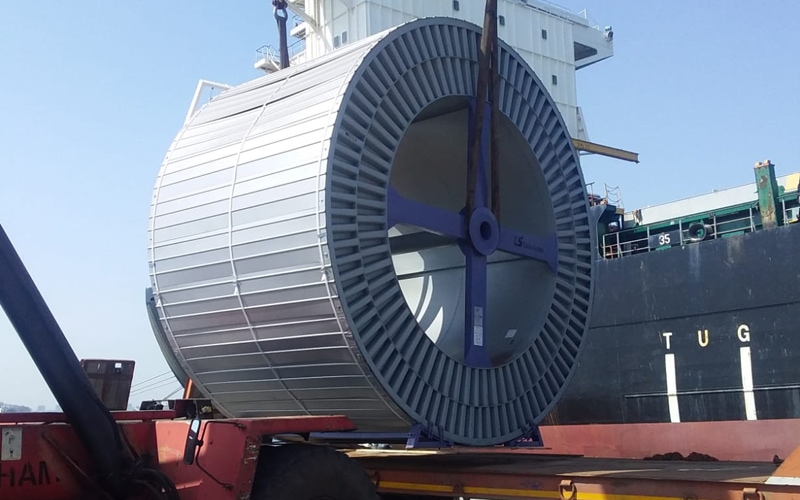
Shippers and specialized transportation providers accomplish the seemingly impossible when they plan and partner to transport oversized, heavyweight, or odd-sized shipments.
Delivering logistics solutions becomes exponentially harder when the cargo in question is jumbo-sized or oddly shaped. The load likely tips the scales as well. Under these circumstances, moving such cargo essentially becomes a project. Between specialized requirements and unforeseen complications, it isn’t easy to achieve what on the surface appears to be impossible.
Here’s a look at how several project logistics providers handled mission-critical challenges: transporting cable on huge reels, moving heavy yet delicate oil and gas upper manifold equipment, and delivering nine pieces of static cargo under a tight deadline.
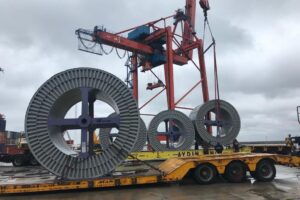
When moving cable reels, the BATI logistics team proactively anticipates any potential issues that might arise and secures the required resources.
The Reel Problem
In today’s hyper-connected world, electric and fiber optic cable for energy transmission and internet communication are both in great demand. The typical method of transporting cable on gigantic reels, however, can cause some logistics headaches.
BATI Innovative Logistics is accustomed to handling various sizes and types of cable reels. A division of the BATI Group of Shipping Companies, a freight forwarding service headquartered in Istanbul, Turkey, the logistics team has already made the arrangements for three different cable shipments in 2023 alone.
“Some ports lack proper equipment suitable for handling reels,” says Ardit Myhidi, project and chartering manager at BATI. In these locations, the logistics team has to proactively address potential issues and secure the required resources.
In January 2023, BATI faced a challenge conducting handling processes for cable reels arriving at the Port of Haydarpaa in Istanbul. BATI was carrying out a discharge operation followed by a shift process to a warehouse. Once the consignee completed the customs procedure, BATI orchestrated the loading onto incoming vehicles.
BATI wasn’t in charge of transportation in this instance but in order to meet specialized handling requirements, a spreader beam was needed to both discharge and reload the cable reels onto trailers. Unfortunately, the port didn’t possess such specialized equipment.
“We had to outsource a certified spreader beam from a third party,” says Myhidi.
Planning ahead allowed BATI logistics professionals to effectively handle the cable reels and fulfill the shipment’s specific requirements. Since BATI is headquartered in Istanbul, the company was already aware of the potential challenges at the Port of Haydarpaa.
To mitigate complications, BATI logistics professionals rented stevedores, cranes, vehicles, and other special equipment from third parties. By proactively addressing potential issues and securing the required resources, the team effectively resolved complications and ensured that the cable reel shipments were handled smoothly.
Several key elements contributed to the project’s success. The BATI Innovative Logistics team works closely with customers, actively engaging with them to understand their unique requirements. Having previous knowledge of handling cable reel shipments and coordinating with various stakeholders resulted in the efficient execution of logistics operations.
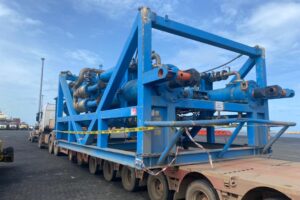
SeaLand Shipping recently transported sensitive oil and gas upper manifold equipment from Tema Port in Ghana to Houston. The cargo was worth several million dollars and weighed more than 50 tons.
A Real Gas
SeaLand Shipping & Inland Services regularly handles project cargo within the oil, gas, and mining industries. The West African company handles logistics in and out of Accra, Ghana—where it is headquartered—to points across the globe. Its projects frequently involve shipping to Houston, generally considered the world’s oil and gas capital.
In June 2023, SeaLand was tasked with handling heavy, yet delicate, oil and gas upper manifold equipment. It needed to travel from Takoradi, a city in Ghana to Tema, the country’s largest port. Once there, it had to be loaded onto a vessel bound for Houston.
The project cargo was valued at several million dollars and weighed more than 50 tons with a volume over 120 CBM (cubic meters). SeaLand had to arrange for special trucks that could handle the cargo weight and dimensions safely.
There also had to be handling equipment in place to ensure the cargo would not incur any damage at the loading and discharging points.
Because SeaLand is triple certified by the International Organization for Standardization in quality management, environmental, and safety systems, the company already had systems in place.
“We prepared and reviewed the lifting plans, route surveys, risk assessment, a marine survey, and lashing certification with the client to gain approval,” says Richard Gaisie, managing director at SeaLand Shipping.
Traffic Jams
However, their work still wasn’t complete. SeaLand also needed to arrange for police escorts to manage road traffic and minimize disruptions for regular road users. And they had to make sure they were compliant with all U.S. Federal Maritime Commission requirements for shipping to U.S. ports, including timely importer security filing.
Despite the police escort and doing a pre-journey route survey to assess the best road to Tema Port, challenges arose.
“We created a lot of traffic moving the cargo from the Takoradi hub to Tema Port,” says Gaisie. “The journey took longer than planned and we had to park many times along the way to ease traffic movement.”
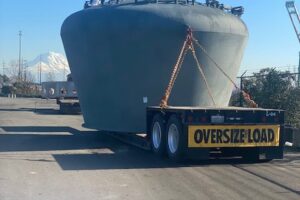
Thunderbolt Global Logistics managed a critical shipment of nine pieces of static cargo from Turkey to Seattle. Due to their size, two pieces required middle-of-the-night delivery.
Under Cover of Night
Dealing with oversized cargo, especially when it’s static—it isn’t self-propelled and cannot be towed—often involves making special accommodations. It was necessary when Baltimore-based Thunderbolt Global Logistics handled the final leg of delivery for nine pieces of static cargo arriving from a Turkish factory into the Port of Tacoma, Washington in March 2022.
Fortunately, six of the nine pieces of static cargo were not oversized and could be delivered on flatbed trucks to the customer. However, three had dimensions that required making special accommodations.
“Due to their size, the two widest pieces could be delivered only on the weekend at night between 1-6 a.m.,” explains Jim Shapiro, Thunderbolt’s owner and director.
Thunderbolt had a delivery deadline to meet and it was critical that the vessel be on time. The entire project was a coordinated effort involving Project Cargo Network partners BATI Shipping, Europe Cargo, and Thunderbolt.
To mitigate potential delays, Thunderbolt obtained customs clearance prior to the shipment’s arrival at the Tacoma port.
Delivery went off without a hitch. In fact, the two widest pieces were delivered by 2:30 a.m. on Saturday, well within the window of time allotted.
The third wide piece with travel restrictions that weren’t as stringent was delivered during the day on Friday. The balance of the shipment was picked up and delivered by flatbed truck the following Monday morning.
Down for the Task
In addition to its regular activities, BATI Innovative Logistics has been involved in various unusual one-off logistics projects. A notable one is the ongoing North Marmara Underground Gas Storage Expansion project in Turkey begun in 2020. This national project involves expanding underground gas storage facilities and is significant for the oil and gas industry.
Yet another remarkable project was the passage operation of the Aras Driller Rig under the 1915 Çanakkale suspension bridge at the Dardanelles Strait. This Turkish bridge is the longest suspension bridge in the world with a main span of 1.26 miles.
The operation posed a unique challenge as the driller rig had 120-meter-high legs that needed to pass under a bridge with a maximum 70-meter air draft. To accomplish this, the legs of the rig had to be lowered 57 meters underwater to achieve the required air draft before passing under the 1915 Çanakkale Bridge, which has a height of approximately 70 meters above water level.
BATI Innovative Logistics conducted a thorough study of the Bathymetry Report to analyze water depths and identify any potential obstacles below the bridge. Every step of this extraordinary operation was reviewed multiple times in collaboration with relevant parties and authorities, ensuring compliance with safety regulations, Marine Warranty Surveyor guidelines, and rig movement and towing procedures.
Prior to approaching the 1915 Çanakkale Bridge, the legs of the rig were lowered 57 meters underwater to meet the required air draft. Once the Aras Driller Rig successfully passed under the bridge, the legs were raised to their fully stowed position and remained raised for the rest of the voyage until arriving at the proposed Bozcaada anchorage in a northeastern part of the Aegean Sea. There, the rig was floated onto the Seaway Eagle, a heavy lift vessel.
For all these project logistics challenges, it was Mission: Possible.
Have Motorcycle, Will Travel
Active travelers have long been able to check bulky items like bicycles, snowboards, skis, surfboards and more when flying to their intended sport destinations. Even a hard stand-up paddleboard is cleared to fly as baggage these days, provided it meets certain height restrictions. Until recently, motorcycle enthusiasts haven’t been as lucky.
That changed in spring 2023 when WestJet Cargo introduced a new service that offers specialized transportation options and tailored logistics solutions for motorcycles. The Canadian airline calls the service BIKE’Air and it’s available on both domestic and international flights connecting Canada to the United States and Europe.
Destinations include Miami, Los Angeles, Barcelona, Dublin, Edinburgh, Paris, Rome and London. The cities can be reached from four stations in Canada—Calgary, Halifax, Toronto, and Vancouver.
Offered from April through October, BIKE’Air lets motorcycle fans transport their bike to one destination, pick it up, ride it to their heart’s content and then return it to any location within its network. Shipments must be booked in advance.
“WestJet Cargo recognizes the potential of motorcycle tourism and is determined to support its growth and culture, by making it even more accessible and appealing to riders,” says Kirsten de Bruijn, executive vice president of WestJet Cargo.
For shipments to/from trans-border (U.S.) and international cities, it’s necessary to contact one of WestJet Cargo’s partners. All domestic, trans-border and international movements require a dangerous goods declaration from a regulated dangerous goods specialist.
Providing air cargo services to businesses, freight forwarders, shippers, and individual customers, WestJet Cargo utilizes the expansive network of WestJet’s wide and narrow-bodied aircraft and its newly introduced fleet of four dedicated Boeing 737-800 converted freighters to meet the diverse needs of its cargo customers.
Each motorcycle is strapped securely to a palette in an upright position before being boarded onto a plane and transported to its final destination. It isn’t necessary for a bike’s owner to be on the same flight—if it also happens to be a passenger plane—or to even fly with WestJet.
3 Tips for Project Logistics Success
1. Prepare for the unexpected. If there’s one thing SeaLand Shipping & Inland Services learned while handling sensitive oil and gas manifold equipment ultimately bound for the United States, it’s best to be overprepared
than underprepared.
“One major lesson for our team is to source a self-propelled modular transporter (SPMT) in the future due to the nature of such cargo and to enhance safety surrounding the project,” says SeaLand Managing Director Richard Gaisie. SPMTs are especially useful wherever there’s no access for a crane or truck.
2. Be flexible. Cable reels are one of the BATI Group of Shipping Companies’ preferred cargoes. The challenge they faced in January 2023 conducting handling processes for cable reels arriving at the Port of Haydarpaşa in Istanbul followed by a shift process to a warehouse underlined a problem.
“Logistics personnel recognized the chosen port wasn’t adequately equipped to handle the specific operation involved in shipping cable reels,” says Ardit Myhidi, Project and Chartering Manager at BATI. As a result, the company has made the decision to shift future shipments to a different port which is better outfitted to handle such operations.
3. Research options. For BATI, the experience highlights the importance of thoroughly assessing and selecting appropriate ports based on their capabilities and suitability for handling specific types of cargo.
It’s a valuable lesson since BATI is actively working on increasing the volume of cable reel shipments. Market research indicates a high demand for energy transmission in 2024. “It will require significant infrastructure investment,” says Myhidi.
Recognizing this potential, BATI Innovative Logistics aims to capitalize on the increasing demand for cable reel shipments and further expand their operations in this area.

